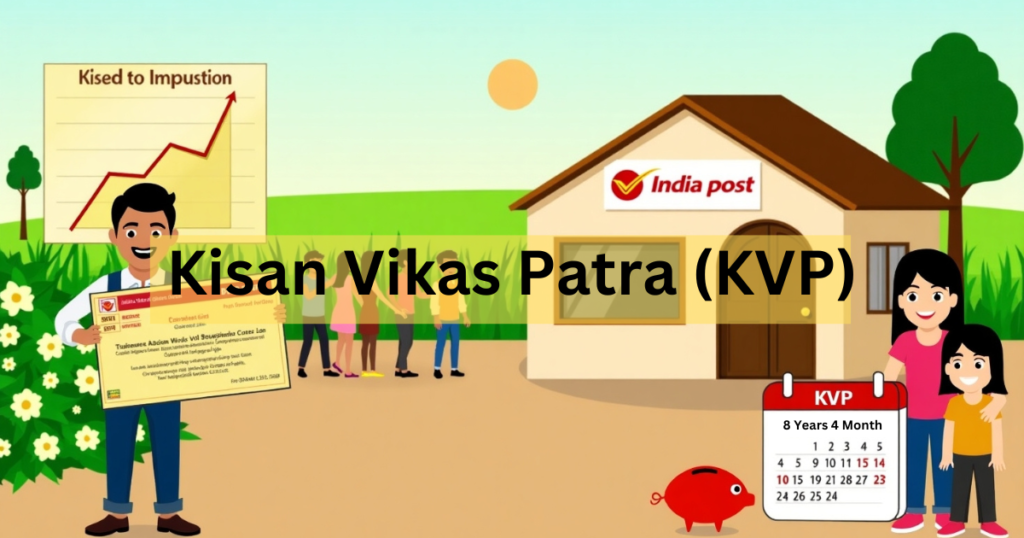
When it comes to safe and reliable investment options, Kisan Vikas Patra (KVP) has been a trusted choice for Indians for decades. This government-backed savings scheme is designed to help individuals grow their wealth over time while ensuring the safety of their hard-earned money. In this blog, we will explore the features, benefits, eligibility criteria, and other essential details of Kisan Vikas Patra (KVP) to help you make an informed investment decision.
What is Kisan Vikas Patra (KVP)?
Kisan Vikas Patra (KVP) is a small savings scheme introduced by the Government of India and offered through post offices across the country. It is a certificate-based investment that doubles your money over a specific period, making it an attractive option for risk-averse investors. The scheme is particularly popular among rural and urban investors who seek long-term financial growth with minimal risk.
Key Features of Kisan Vikas Patra (KVP)
- Doubling of Investment:
The primary feature of Kisan Vikas Patra (KVP) is that it doubles the invested amount over a predetermined period. As of October 2023, the current doubling period is 124 months (10 years and 4 months). - Government-Backed Security:
KVP is a government-backed scheme that offers a high level of security. The government of India guarantees your investment, making it one of the safest investment options available. - Flexible Investment Amount:
The minimum investment required to purchase a KVP certificate is ₹1,000, with no upper limit. This makes it accessible to investors from all income groups. - Attractive Interest Rates:
The interest rate for Kisan Vikas Patra (KVP) is revised quarterly by the government. As of October 2023, the interest rate stands at 7.5% per annum, compounded annually. - Easy Transferability:
KVP certificates can be easily transferred from one person to another, making them a convenient investment option. - Nomination Facility:
Investors can nominate a beneficiary to ensure the smooth transfer of funds in case of unforeseen circumstances.
Eligibility Criteria for Kisan Vikas Patra (KVP)
The Kisan Vikas Patra (KVP) scheme is open to the following individuals:
- Indian Residents: Any Indian citizen can invest in KVP.
- Minors: A minor can purchase a KVP certificate under the guardianship of a parent or guardian.
- Joint Accounts: Up to three individuals can jointly invest in KVP.
Non-resident Indians (NRIs) and Hindu Undivided Families (HUFs) are ineligible to make investments in KVP.
How to Invest in Kisan Vikas Patra (KVP)
Investing in Kisan Vikas Patra (KVP) is a simple and hassle-free process. Here’s how you can do it:
- Visit your nearest post office.
- Fill out the KVP application form.
- Submit the required documents, such as identity proof, address proof, and photographs.
- Deposit the investment amount through cash, cheque, or demand draft.
- Collect your KVP certificate, which will contain all the details of your investment.
Benefits of Investing in Kisan Vikas Patra (KVP)
- Guaranteed Returns:
The doubling of the invested amount over a fixed period ensures guaranteed returns, making KVP a reliable investment option. - Low Risk:
As a government-backed scheme, KVP carries minimal risk, making it ideal for risk-averse investors. - Flexible Investment:
With no upper limit on investment, KVP is suitable for both small and large investors. - Easy Liquidity:
While KVP has a lock-in period, it can be encashed prematurely after 2.5 years (30 months) in case of emergencies, subject to certain conditions. - Transferability:
KVP certificates can be transferred from one person to another, providing flexibility to investors.
Drawbacks of Kisan Vikas Patra (KVP)
While Kisan Vikas Patra (KVP) offers several benefits, it also has a few limitations:
- Taxable Interest:
The interest earned from KVP is fully taxable under the Income Tax Act, which may reduce the overall returns for investors in higher tax brackets. - No Tax Deductions:
Unlike other small savings schemes like PPF or NSC, investments in KVP do not qualify for tax deductions under Section 80C. - Lock-In Period:
The scheme has a lock-in period of 2.5 years (30 months), which may not be suitable for those seeking short-term liquidity.
Comparison with Other Investment Options
When compared to other fixed-income instruments like Fixed Deposits (FDs) and Public Provident Fund (PPF), Kisan Vikas Patra (KVP) stands out due to its government-backed security and guaranteed returns. However, the lack of tax benefits and the taxable nature of interest may make other schemes more attractive for tax-saving purposes.
Tips for Maximizing Returns from Kisan Vikas Patra (KVP)
- Plan for Taxes:
Since the interest earned is taxable, plan your investments in a way that minimizes your tax liability. - Use as a Long-Term Investment:
KVP is ideal for long-term financial goals due to its doubling feature and low-risk nature. - Consider Joint Investments:
If you want to invest a large amount, consider joint investments to take advantage of the flexibility and transferability of KVP certificates.
Conclusion
Kisan Vikas Patra (KVP) is a reliable and secure investment option for Indians seeking guaranteed returns with minimal risk. With its government-backed security, flexible investment limits, and attractive interest rates, KVP is an excellent choice for risk-averse investors and those looking for long-term financial growth.
However, it is essential to consider the tax implications and lock-in period before investing. By understanding the features and benefits of Kisan Vikas Patra (KVP), you can make an informed decision and secure your financial future.
If you’re looking for a safe and steady investment avenue, Kisan Vikas Patra (KVP) is undoubtedly worth considering. Visit your nearest post office today to purchase a KVP certificate and start growing your wealth
For more government schemes and yojanas, visit us: https://yojanatrack.com